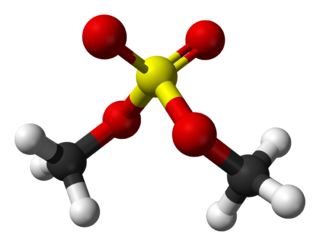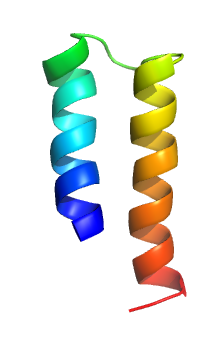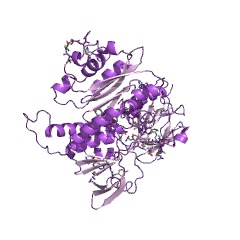Related Research Articles
Methylation, in the chemical sciences, is the addition of a methyl group on a substrate, or the substitution of an atom by a methyl group. Methylation is a form of alkylation, with a methyl group replacing a hydrogen atom. These terms are commonly used in chemistry, biochemistry, soil science, and biology.

DNA methylation is a biological process by which methyl groups are added to the DNA molecule. Methylation can change the activity of a DNA segment without changing the sequence. When located in a gene promoter, DNA methylation typically acts to repress gene transcription. In mammals, DNA methylation is essential for normal development and is associated with a number of key processes including genomic imprinting, X-chromosome inactivation, repression of transposable elements, aging, and carcinogenesis.

Methylmercury (sometimes methyl mercury) is an organometallic cation with the formula [CH3Hg]+. It is the simplest organomercury compound. Methylmercury is extremely toxic, and its derivatives are the major source of organic mercury for humans. It is a bioaccumulative environmental toxicant.

Sulfate-reducing microorganisms (SRM) or sulfate-reducing prokaryotes (SRP) are a group composed of sulfate-reducing bacteria (SRB) and sulfate-reducing archaea (SRA), both of which can perform anaerobic respiration utilizing sulfate (SO2−
4) as terminal electron acceptor, reducing it to hydrogen sulfide (H2S). Therefore, these sulfidogenic microorganisms "breathe" sulfate rather than molecular oxygen (O2), which is the terminal electron acceptor reduced to water (H2O) in aerobic respiration.

Dimethyl sulfate (DMS) is a chemical compound with formula (CH3O)2SO2. As the diester of methanol and sulfuric acid, its formula is often written as (CH3)2SO4 or Me2SO4, where CH3 or Me is methyl. Me2SO4 is mainly used as a methylating agent in organic synthesis.
Histone methylation is a process by which methyl groups are transferred to amino acids of histone proteins that make up nucleosomes, which the DNA double helix wraps around to form chromosomes. Methylation of histones can either increase or decrease transcription of genes, depending on which amino acids in the histones are methylated, and how many methyl groups are attached. Methylation events that weaken chemical attractions between histone tails and DNA increase transcription because they enable the DNA to uncoil from nucleosomes so that transcription factor proteins and RNA polymerase can access the DNA. This process is critical for the regulation of gene expression that allows different cells to express different genes.

Sulfur assimilation is the process by which living organisms incorporate sulfur into their biological molecules. In plants, sulfate is absorbed by the roots and then be transported to the chloroplasts by the transipration stream where the sulfur are reduced to sulfide with the help of a series of enzymatic reactions. Furthermore, the reduced sulfur is incorporated into cysteine, an amino acid that is a precursor to many other sulfur-containing compounds. In animals, sulfur assimilation occurs primarily through the diet, as animals cannot produce sulfur-containing compounds directly. Sulfur is incorporated into amino acids such as cysteine and methionine, which are used to build proteins and other important molecules. Besides, With the rapid development of economy, the increase emission of sulfur results in environmental issues, such as acid rain and hydrogen sulfilde.

Methyltransferases are a large group of enzymes that all methylate their substrates but can be split into several subclasses based on their structural features. The most common class of methyltransferases is class I, all of which contain a Rossmann fold for binding S-Adenosyl methionine (SAM). Class II methyltransferases contain a SET domain, which are exemplified by SET domain histone methyltransferases, and class III methyltransferases, which are membrane associated. Methyltransferases can also be grouped as different types utilizing different substrates in methyl transfer reactions. These types include protein methyltransferases, DNA/RNA methyltransferases, natural product methyltransferases, and non-SAM dependent methyltransferases. SAM is the classical methyl donor for methyltransferases, however, examples of other methyl donors are seen in nature. The general mechanism for methyl transfer is a SN2-like nucleophilic attack where the methionine sulfur serves as the leaving group and the methyl group attached to it acts as the electrophile that transfers the methyl group to the enzyme substrate. SAM is converted to S-Adenosyl homocysteine (SAH) during this process. The breaking of the SAM-methyl bond and the formation of the substrate-methyl bond happen nearly simultaneously. These enzymatic reactions are found in many pathways and are implicated in genetic diseases, cancer, and metabolic diseases. Another type of methyl transfer is the radical S-Adenosyl methionine (SAM) which is the methylation of unactivated carbon atoms in primary metabolites, proteins, lipids, and RNA.

Methionine synthase reductase, also known as MSR, is an enzyme that in humans is encoded by the MTRR gene.
Sulfur is metabolized by all organisms, from bacteria and archaea to plants and animals. Sulfur can have an oxidation state from -2 to +6 and is reduced or oxidized by a diverse range of organisms. The element is present in proteins, sulfate esters of polysaccharides, steroids, phenols, and sulfur-containing coenzymes.

Desulfovibrio vulgaris is a species of Gram-negative sulfate-reducing bacteria in the Desulfovibrionaceae family. It is also an anaerobic sulfate-reducing bacterium that is an important organism involved in the bioremediation of heavy metals in the environment. Desulfovibrio vulgaris is often used as a model organism for sulfur-reducing bacteria and was the first of such bacteria to have its genome sequenced. It is ubiquitous in nature and has also been implicated in a variety of human bacterial infections, although it may only be an opportunistic pathogen. This microbe also has the ability to endure high salinity environments, which is done through the utilization of osmoprotectants and efflux systems.
Arsenic biochemistry refers to biochemical processes that can use arsenic or its compounds, such as arsenate. Arsenic is a moderately abundant element in Earth's crust, and although many arsenic compounds are often considered highly toxic to most life, a wide variety of organoarsenic compounds are produced biologically and various organic and inorganic arsenic compounds are metabolized by numerous organisms. This pattern is general for other related elements, including selenium, which can exhibit both beneficial and deleterious effects. Arsenic biochemistry has become topical since many toxic arsenic compounds are found in some aquifers, potentially affecting many millions of people via biochemical processes.

The mercury transporter superfamily is a family of transmembrane bacterial transporters of mercury ions. The common origin of all Mer superfamily members has been established. The common elements between family members are included in TMSs 1-2. A representative list of the subfamilies and proteins that belong to those subfamilies is available in the Transporter Classification Database.
(Methyl-Co methylamine-specific corrinoid protein):coenzyme M methyltransferase is an enzyme with systematic name methylated monomethylamine-specific corrinoid protein:coenzyme M methyltransferase. This enzyme catalyses the following chemical reaction
5-methyltetrahydrofolate:corrinoid/iron-sulfur protein Co-methyltransferase is an enzyme with systematic name 5-methyltetrahydrofolate:corrinoid/iron-sulfur protein methyltransferase. This enzyme catalyses the following chemical reaction
Syntrophobacter wolinii is a non-motile, gram-negative and rod-shaped species of bacteria that was originally isolated from a wastewater digester. This species is able to perform propionate degradation and sulfate reduction. S. wolinii can be grown in co-culture or pure culture. 16s rRNA analysis shows its close relation to other sulfate reducers.
Arsenate-reducing bacteria are bacteria which reduce arsenates. Arsenate-reducing bacteria are ubiquitous in arsenic-contaminated groundwater (aqueous environment). Arsenates are salts or esters of arsenic acid (H3AsO4), consisting of the ion AsO43−. They are moderate oxidizers that can be reduced to arsenites and to arsine. Arsenate can serve as a respiratory electron acceptor for oxidation of organic substrates and H2S or H2. Arsenates occur naturally in minerals such as adamite, alarsite, legrandite, and erythrite, and as hydrated or anhydrous arsenates. Arsenates are similar to phosphates since arsenic (As) and phosphorus (P) occur in group 15 (or VA) of the periodic table. Unlike phosphates, arsenates are not readily lost from minerals due to weathering. They are the predominant form of inorganic arsenic in aqueous aerobic environments. On the other hand, arsenite is more common in anaerobic environments, more mobile, and more toxic than arsenate. Arsenite is 25–60 times more toxic and more mobile than arsenate under most environmental conditions. Arsenate can lead to poisoning, since it can replace inorganic phosphate in the glyceraldehyde-3-phosphate --> 1,3-biphosphoglycerate step of glycolysis, producing 1-arseno-3-phosphoglycerate instead. Although glycolysis continues, 1 ATP molecule is lost. Thus, arsenate is toxic due to its ability to uncouple glycolysis. Arsenate can also inhibit pyruvate conversion into acetyl-CoA, thereby blocking the TCA cycle, resulting in additional loss of ATP.

Mercury(II) reductase (EC 1.16.1.1), commonly known as MerA, is an oxidoreductase enzyme and flavoprotein that catalyzes the reduction of Hg2+ to Hg0. Mercury(II) reductase is found in the cytoplasm of many eubacteria in both aerobic and anaerobic environments and serves to convert toxic mercury ions into relatively inert elemental mercury.

Mercury is a heavy metal that cycles through the atmosphere, water, and soil in various forms to different parts of the world. Due to this natural mercury cycle, irrespective of which part of the world releases mercury it could affect an entirely different part of the world making mercury pollution a global concern. Mercury pollution is now identified as a global problem and awareness has been raised on an international action plan to minimize anthropogenic mercury emissions and clean up mercury pollution. The 2002 Global Mercury Assessment concluded that “International actions to address the global mercury problem should not be delayed”. Among many environments that are under the impact of mercury pollution, the ocean is one which cannot be neglected as it has the ability to act as a “storage closet” for mercury. According to a recent model study the total anthropogenic mercury released into the ocean is estimated to be around 80,000 to 45,000 metric tons and two-thirds of this amount is estimated to be found in waters shallower than 1000m level where much consumable fish live. Mercury can get bio-accumulated in marine food chains in the form of highly toxic methyl mercury which can cause health risks to human seafood consumers. According to statistics, about 66% of global fish consumption comes from the ocean. Therefore, it is important to monitor and regulate oceanic mercury levels to prevent more and more mercury from reaching the human population through seafood consumption.
Desulfovibrio desulfuricans is a Gram-negative sulfate-reducing bacteria. It is generally found in soil, water, and the stools of animals, although in rare cases it has been found to cause infection in humans. It is particularly noted for its ability to produce methyl mercury. The reductive glycine pathway, a seventh route for organisms to capture CO2, was discovered in this species. Since these bacteria are killed by exposure to atmospheric oxygen, the environmental niches most frequently occupied by these bacteria are anaerobic. Desulfovibrio desulfuricans 27774 was reported to produce gene transfer agents.
References
- ↑ Fleming EJ, Mack EE, Green PG, Nelson DC (January 2006). "Mercury methylation from unexpected sources: molybdate-inhibited freshwater sediments and an iron-reducing bacterium". Applied and Environmental Microbiology. 72 (1): 457–64. doi:10.1128/AEM.72.1.457-464.2006. PMC 1352261 . PMID 16391078.
- 1 2 3 4 5 6 7 8 9 10 11 12 13 14 15 Bystrom E. Assessment of mercury methylation and demethylation with focus on chemical speciation and biological processes (PDF) (Ph.D. thesis). Georgia Institute of Technology.
- 1 2 Selin, Noelle E. (2009-10-15). "Global Biogeochemical Cycling of Mercury: A Review". Annual Review of Environment and Resources. 34 (1): 43–63. doi: 10.1146/annurev.environ.051308.084314 . ISSN 1543-5938.
- 1 2 3 4 Poulain AJ, Barkay T (March 2013). "Environmental science. Cracking the mercury methylation code". Science. 339 (6125): 1280–1. Bibcode:2013Sci...339.1280P. doi:10.1126/science.1235591. PMID 23493700. S2CID 206547954.
- 1 2 3 Ghimire PS, Tripathee L, Zhang Q, Guo J, Ram K, Huang J, Sharma CM, Kang S (2019-12-20). "Microbial mercury methylation in the cryosphere: Progress and prospects". Science of the Total Environment. 697: 134150. Bibcode:2019ScTEn.697m4150S. doi:10.1016/j.scitotenv.2019.134150. ISSN 0048-9697. PMID 32380618. S2CID 202870490.
- ↑ Date SS, Parks JM, Rush KW, Wall JD, Ragsdale SW, Johs A (2019-01-04). "Kinetics of enzymatic mercury methylation at nanomolar concentrations catalyzed by HgcAB: Supplementary information". bioRxiv: 510180. doi: 10.1101/510180 .
- 1 2 3 4 Gilmour CC, Bullock AL, McBurney A, Podar M, Elias DA (April 2018). Lovley DR (ed.). "Robust Mercury Methylation across Diverse Methanogenic Archaea". mBio. 9 (2): e02403–17, /mbio/9/2/mBio.02403–17.atom. doi:10.1128/mBio.02403-17. PMC 5893877 . PMID 29636434.
- ↑ Kelly CA, Rudd JW, Holoka MH (July 2003). "Effect of pH on mercury uptake by an aquatic bacterium: implications for Hg cycling". Environmental Science & Technology. 37 (13): 2941–6. Bibcode:2003EnST...37.2941K. doi:10.1021/es026366o. PMID 12875398.
- 1 2 3 Date SS, Parks JM, Rush KW, Wall JD, Ragsdale SW, Johs A (July 2019). Kivisaar M (ed.). "Kinetics of Enzymatic Mercury Methylation at Nanomolar Concentrations Catalyzed by HgcAB". Applied and Environmental Microbiology. 85 (13): e00438–19, /aem/85/13/AEM.00438–19.atom. doi:10.1128/AEM.00438-19. PMC 6581168 . PMID 31028026.
- 1 2 An J, Zhang L, Lu X, Pelletier DA, Pierce EM, Johs A, et al. (June 2019). "Mercury Uptake by Desulfovibrio desulfuricans ND132: Passive or Active?". Environmental Science & Technology. 53 (11): 6264–6272. Bibcode:2019EnST...53.6264A. doi:10.1021/acs.est.9b00047. OSTI 1530103. PMID 31075193. S2CID 149454648.
- ↑ Zhang L, Wu S, Zhao L, Lu X, Pierce EM, Gu B (March 2019). "Mercury Sorption and Desorption on Organo-Mineral Particulates as a Source for Microbial Methylation". Environmental Science & Technology. 53 (5): 2426–2433. Bibcode:2019EnST...53.2426Z. doi:10.1021/acs.est.8b06020. OSTI 1509536. PMID 30702880. S2CID 73449064.